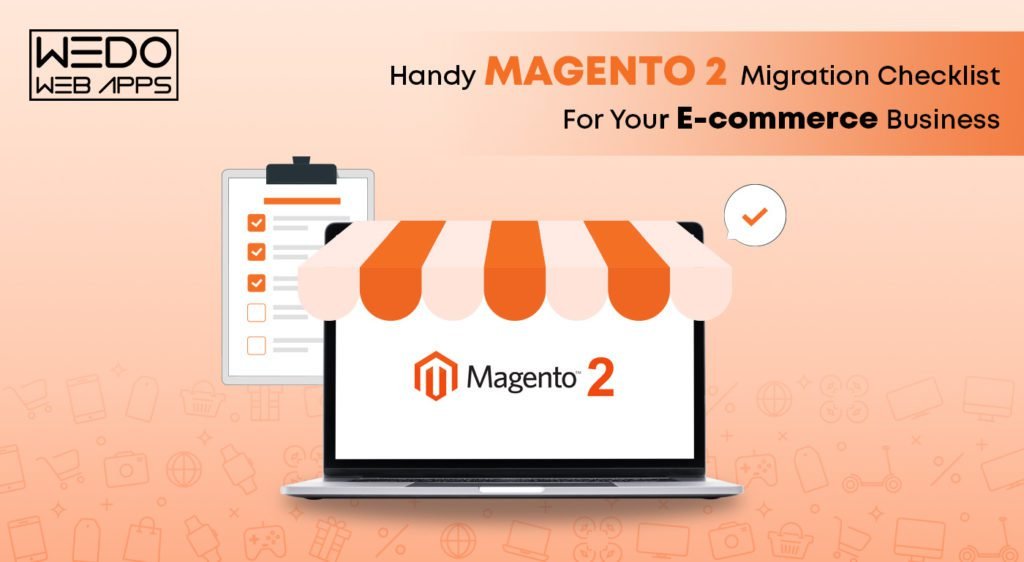21 Feb, 2023 | Magento Custom Development
Handy Magento 2 Migration Checklist For Your E-commerce Business

Why Should You Migrate to Magento 2?
In June 2020, Magento officially declared the termination of updates and support for the first version. Since then, there has been a surge of problems and interruptions across the Magento community and the whole eCommerce industry. But on November 17, 2015, Magento released its 2.0 version, which was way better and more useful than the first version. Take a look at why you should migrate to Magento 2.0 as soon as possible.Reasons For Magento 2 Migration
- Improved performance with data migration tool code.
- Completely responsive and touch-friendly UX design
- More occasional needs for intermediary custom extensions
- Simple to modify and remodel
- Reasonable in price with an easy-to-use Magento 2 migration service access
- Enhanced load time and quicker processing with handy maintenance mode
- Efficient and smooth-running backend along with enhanced UX for admin panel with such migration testing environment.
Things To Consider During Magento 2 Migration
Since Magento data migration tool, developing technologies, and manual data changes make switching platforms simpler than ever, it is still a time-intensive and unwieldy task. According to Allen Burt (CEO at Blue Stout), the purpose behind a migration plan should never be only to shift from one platform to another or transferring data. Rather, it should be to “concentrate on the opportunities that are obtainable to the respective brand or business as they switch. Double check you take the maximum benefit of that transformation to enhance your website for revenue growth.” Moreover, irrespective of your needs or logic that made you run the migration process, make sure you make thorough inquiries during the discovery stage. Now let’s look at the most crucial incremental data migration step, along with a helpful Magento 2 migration checklist.1. Devise A Migration 2 migration Strategy
Taking into account the complexity of migrating to Magento 2, you must create a strategy that facilitates you to succeed in the migration journey. A good migration process plan will work as a flowchart and agenda to direct you through the migration attainments. Nevertheless, if you are an amateur in the migration process and require some assistance, Magento has released a flowchart that could help you with data migration.2. Decide What Features You Require
Find out what technology you are using and discard the elements that result in errors if you are spending on features that you don’t even require. As per Paul Byrne, President at Razoyo. “If you have been using Magento for a number of years and have custom-made it for enhanced existing custom functionality, possibilities are you are still not making use of every magento core customizations. Have a list of everything you require.” Several functionalities in the Magento 2 platform and the Magento Marketplace are obtainable from various expert providers in the BigCommerce App Marketplace. “Many of the services you utilized on Magento are available there, including incrementally captured data updates; some are furnished by other modules,” states Paul.3. Pay Heed To Development Time And The Overall Expense Of Ownership:
Migrating to cloud-based e-commerce solutions normally requires a reduced overall expense of ownership, states Ethan Giffin, Founder, and CEO at Groove Commerce. “This generally happens because on-premise solutions such as Magento mandate hosting fees, Enterprise license fees, and constant support.” Magento is an open-source, wholly configurable platform with hosted and cloud-based alternatives. Since it is absolutely robust, brands are usually amazed by the expenses of employing development and design teams to create and adjust their front- and back-ends on the platform. Unlike a fixed-cost SaaS option, with on-premise software, “you will have to spend to host the software somewhere. The more additional traffic and data you own, the more money it will cost.” The expenses can be even higher than the software hosting. When brands choose a hosted solution, they should also pay heed to the costs linked with the items mentioned below:- Production Hardware
- Server licensing
- Load-balancing
- Backups
- PCI compliance.

4. Ensure Accurate Timings
With Magento Commerce 1 (Enterprise Edition) and Magento Open Source (Community Edition end-of-life), which will be out in June 2020, numerous brands must pay heed to quick platform migration, particularly to permit extra time for development and post-launch testing environment. If you wonder how long it takes for Magento to migrate to a new e-commerce platform, here's a quick answer. It relies on the intricacy of your e-commerce business and how fast your business can make decisions, As attested by Paul at Razoyo. "We have done platform migrations and settings migration for simple stores in as few as eight weeks. Others have taken a year or more. Take the time you require to do it precisely." Johnny at Fortuitas states that if you are associated with an agency for various incremental migration purposes and a Magento migration plan, then make an early discovery to identify the ideal timeline. “These are small, quick engagements that permit an agency to plunge deeper into a brand’s systems. Once done, not just the brand will have a adequate understanding of where they are presently, but it likewise gets suggestions on where business can be in the next 3-5 years. The discovery will specify an exact plan and budget and make it straightforward for the client to make a decision on which platform to pick.” Read also: Hire Dedicated BigCommerce Developers5. Should You Hire A Team For Development Resources?
With an open-source platform like Magento, businesses should have a support and development crew for any more extensive adjustments or changes to the platform. Since it is possible for bigger businesses with built-out support units, small-sized and rising merchants may face problems in allocating the correct budget and headcount to developers. Why are developers and developer authentication keys required? There are a few safety exposures and mandated bug fixes linked with on-premise platforms, states Paul at Razoyo. “OSPs contain bugs, and if the platform does not talk about the bug you have to fix, you may have to pay a development team to resolve it for you.”6. Safety: Consider The Protection You Need In Advance:
Website safety is indispensable for every e-commerce business that sells products online. Almost monthly announcements are about the lack of protection and patch fixes for the latest Magento migrate data software. In point of fact, the latest research has discovered that 87% of SME websites utilizing the Magento platform are presently at increased threat of cyber attacks. “Security threats occurs regularly. Magento normally issues an update to resolve the new threat, but occasionally those updates — either safety patches or upgrades — result in other things to stop working, so you have to spend time experimenting and fixing any problems you encounter.” — Paul Byrne, President at Razoyo.7. PCI Compliance:
PCI compliance is a subset of standards designed to assure that the credit card industry systematically protects customer data and data transfer processes. It is mandated for all businesses that process credit card payments. According to Paul, a PCI compliance audit is the most pricey thing a trader can encounter. “A PCI compliance audit is when your bank or merchant service provider mandates you to demonstrate that customer store data is safe. With Magento, you have to verify it independently. If you are on BigCommerce, the process is often more straightforward.” Businesses that worry about migrate settings from Magento 1 to Magento 2 will nonetheless be on a hosted solution and will have to retain a staging server or spend on a provider for the same, which implies that they are still answerable for retaining PCI compliance and patching. “The expenses to purchase and support hosted PCI compliant and separate environment are far more significant than if you opted for an out of the box PCI compliant SaaS solution such as BigCommerce.” states Johnny at Fortuitas.8. Specify Your Tech Stack And Decide The Features You Require As Per Development Environment:
Look at some of the features and customize functionality of the current platform you mostly use.- Shipping.
- Multi-channel.
- International localization.
- Wholesale distributions.
- Headless commerce.
- Mobile optimization.
- SEO.
- Faceted search.
- Theme & storefront personalization.
- Merchandising.
- Coupons & discounts.
9. Pay Heed To Redesigns And Modifications:
When you have migrated data and moved from one platform to another, you will not necessarily get a shopfront's exact appearance and feel. For businesses shifting from Magento 1 to Magento 2 and migrating data, not every theme and extension created for Magento 1 will be well-matched and compatible with Magento 2 version control system. You will have to do more migration testing, extensive code migration, upgrade migration, and extension migration for personalized features or functionalities. If you are encountering the problem of recreating the same look on your new e-commerce website, you might also move to a more suitable solution rather than only a theme migration. Read also about PSD to Drupal and Magento Conversion10. Take Help From External Resources:
According to Paul Byrne, President of Razoyo, “BigCommerce is highly customizable. If you have complicated requirements, find a partner early on who can assist you plan things. A fantastic plan will save you time, money and headaches as you move.” Thus, it becomes crucial to take help with your eCommerce store from as many external resources as possible for a better experience.
Conclusion
Rome was not built in a single day, so if you are still unable to decide whether you should opt for Magento migration, then this is the right time to do it. Replatforming, or opting for a Magento 2 migration service is not simple; however, you must see it as an investment in your online store. It will certainly succeed and give you more sales and increased revenues. Moreover, Magento 1 to Magento 2 migration gives you future timeliness to the most recent technologies and features, such as PHP with the newest techniques, e.g., Database assets, new Database entities, database clustering, incremental updates, network access, Performance Monitoring via New Relic, Full Page Caching, Blackfire.io, Extended Reporting via Magento e-commerce Business Intelligence, Pagebuilder WYSIWYG CMS, Magento Shipping and LAMP stack – Linux, Apache/Nginx MySq. So waste no more time and switch to a more enhanced version of Magento 2.0 today.Frequently Asked Questions
What are the benefits of Magento 2, and why is it better than Magento 1 migration process?
Magento 1 has moderate page load speeds of around two seconds. The loading time in Magento 2 is quicker. It is combined with Varnish Cache to decrease server load. Magento 2 loads home, product, and category pages in less than 1.5 seconds.
Which is the most suitable data migration tool?
Here's a list of the best data migration tool's that you can use:
- Stitch Data
- AWS Data Pipeline
- Hevo Data
- Fivetran
- Matillion
- Azure DocumentDB
- Integrate.io
- IBM Informix.
What are the two kinds of processes in Magento migration?
The two kinds of processes involved in Magento Migration include:
- Non-preemptive Process: If a process is carried out before it starts implementation on its source node, it is called a non-preemptive process.
- Preemptive Process: If a process is carried out at the time of its implementation, it is called preemptive process migration.
When it comes to whether you should migrate Magento to shopify, the answer is, you must read and understand that first. That is a completely different chapter to read and understand.

